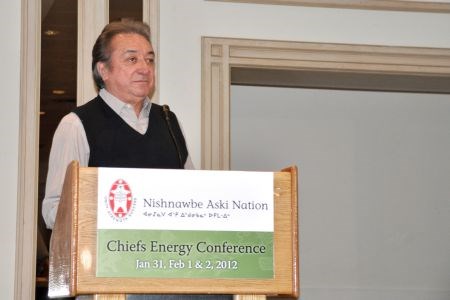Crisis is a word Canadians are hearing lately in terms of Northern First Nation communities. But the Nishnawbe Aski Nation (NAN) said many of its communities face an annual crisis when it comes to its energy supply.
Nearly half of the 49 First Nation communities represented by NAN rely on diesel generators for their energy needs. It is very costly to run the current electrical generation system due to the high cost of transporting diesel fuel. With warm weather, winter roads are becoming less reliable and the cost of flying in fuel is even greater.
To address this issue and develop short- and long-term strategies, the NAN executive council, NAN chiefs and tribal councils, industry, government and other interested parties met for a three-day energy conference Jan. 31 to Feb. 2 in Thunder Bay.
About 225 participants registered for the event that included government agencies; such as the Ontario Power Authority (OPA), Ontario Power Generation (OPG), officials from the Ministry of Natural Resources, Ministry of Northern Development and Mines, and industry experts such as solar and wind energy consultants.
Constance Lake First Nation Chief Roger Wesley said that while his community is fortunate to already be linked to the Ontario grid, the delivery cost is a major issue, in particular for homes still relying on electricity as their sole energy source. The monthly electricity bill for some houses that are heated by electrical baseboard heaters can be as high as $800 or $900 from December to February.
“So we have to explore other options,” said Wesley.
One of those options in the short-term may be Ontario’s Feed-In Tariff (FIT) program. “We would like the province of Ontario to institute a remote FIT program that would allow the communities who now have some local generation projects such as wind, solar, etc. to provide that local source of energy to the community distribution,” said NAN Deputy Grand Chief Les Louttit.“Then in the long term, they can then leverage the purchase agreements to finance those projects and be able to sell back into the grid and have another source of revenue that they could reinvest.”
Louttit said they have also been discussing the possibility of transporting fuel to remote communities using dirigibles.
In the long term, NAN chiefs would like to see all of their communities on the power grid by 2018. The extension would be part of the Ontario power grid, but owned and operated by NAN regional utilities. Planning, construction and eventual ownership will be in the hands of First Nations to stimulate economic growth and provide for business opportunities, as well as enable the development of renewable power generation within NAN communities.
Louttit says there is reason to be optimistic. The only First Nation-owned electricity transmission company in Canada, Five Nations Energy corporation, is headquartered in Moose Factory and serves the remote First Nation communities of Attawapiskat, Fort Albany and Kashechewan.
He remembers being in one of those communities shortly after it had been connected. “Everybody was so happy, they were using power left and right, plugging in appliances, satellite (TVs), gadgets.” Suddenly communities that were completely dark were holding contests for the best Christmas light display.
The result was a higher electrical bill than ever before. Now, Five Nations Energy is focused on conservation measures and educating their customers about peak times and how to lower their energy bill.
Chief Roger Wesley was encouraged by the outcome of the conference, in particular, the plan to eventually place the ownership of the utilities in the hands of First Nation communities.
“I am very encouraged to see that NAN Chiefs are going to work together to start developing strategies that will move us into the economy as equal participants and equal benefactors. First Nations need to be equal shareholders with options to be full partners in any of these developments because we’re the ones that live here.” Wesley said that while energy is a necessity, it is also a great financial opportunity that could be used to help communities address some of the challenges they face in education, health and other areas.
“The First Nations need it – we’re the ones living in Third World conditions,” said Wesley.
“From what I heard today, it’s a statement to the world that the Nishnawbe Aski Nation is here and we’ve been here all along and now it’s time to include us in this industry. The cost of not including us is just too great, not only for our people but also for the province.”




